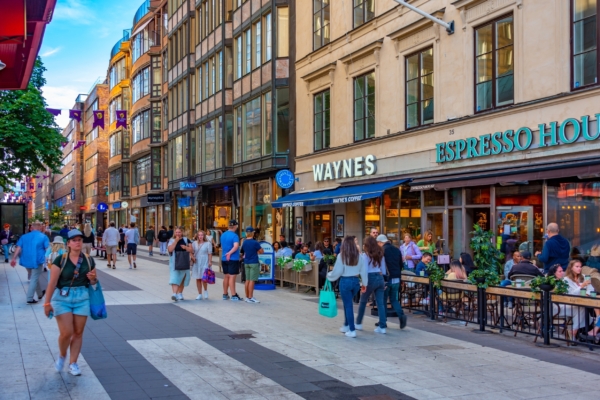For decades, the governments of Nordic countries have been more welcoming towards immigrants compared to many other European nations. Politicians from various political parties have put forward various reasons for this approach, including humanitarian reasons, population needs, and economic benefits. Additionally, they have taken pride in building “multicultural societies” and have placed lower demands on the integration of foreign immigrants into their societies.
However, now, Nordic countries such as Sweden, Norway, Denmark, Finland, and Iceland are reducing the number of incoming immigrants and raising requirements regarding language skills, cultural assimilation, economic independence, and civic knowledge.
There are many factors contributing to this shift, including welfare costs, housing shortages, crime rates, unemployment, social unrest, and cultural tensions. Meanwhile, anti-immigrant parties like the Progress Party in Norway, the True Finns in Finland, the Democrats in Sweden, and the People’s Party in Denmark have achieved success in elections, forcing established politicians to reconsider their elite-driven efforts and ultimately reversing several long-standing policies.
This transformation began in Denmark when Prime Minister Mette Frederiksen of the Social Democrats announced a “paradigm shift” in 2019, shifting the focus from inclusion to deterrence and repatriation. Denmark terminated refugee residency permits, increased repatriation efforts, and implemented forced relocations in areas with a higher concentration of non-Western residents. Denmark now follows a policy of “zero net asylum seekers,” characterized by limited welfare benefits, strict family reunification rules, and accelerated deportations.
Over time, other Nordic countries have followed suit, adopting similar policies. Norway has reduced refugee benefits and allowances, while Finland has decreased refugee quotas, introduced stricter citizenship requirements, and imposed stricter conditions for family reunification. Even in Iceland, where historically fewer immigrants have been accepted compared to its Nordic neighbors, the rapid growth of foreign-born populations has raised concerns about immigration and lack of integration.
However, the most significant changes have occurred in Sweden. For decades, both left-wing and right-wing governments in Sweden have upheld an open border policy. Consequently, the country’s population has grown from 8 million to 10 million since the 1990s, primarily due to immigrants from culturally diverse and conflict-affected regions such as Africa and the Middle East. The population surge has led to issues of rising welfare costs, crime, social and cultural tensions between Swedes and immigrants, as well as among different immigrant populations. Due to the long-standing failure of Swedish officials to acknowledge and effectively address these negative impacts, the political backlash has become very severe. In the 2022 elections, the anti-immigrant Sweden Democrats garnered over 20% of the vote, becoming the second-largest party and a significant force in the Swedish parliament (Riksdag).
As a result, the minority center-right government that took office in October of that year had to reach a controversial agreement with the Sweden Democrats on their proactive stance on issues and then implement significant reforms, including tightening asylum and residency permit restrictions, stricter family reunification regulations, raising income requirements for work visas, and strongly encouraging immigrant repatriation. Additionally, new citizenship requirements soon extended the residency period from five to eight years, requiring evidence of a “honest life” free of crime and debt, language tests, proof of self-sufficiency, and formal integration commitments.
Therefore, all Nordic countries have reduced their acceptance of immigrants and increased requirements for societal integration. However, these changes have come too late, too slowly, and with hesitation, and the economic, social, cultural, and other impacts of decades of large-scale immigration and weak assimilation are becoming increasingly unsustainable. Furthermore, left-wing parties, human rights associations, immigrant groups, and media strongly oppose the changes, tending to label all restrictive and stringent measures as unnecessary, harsh, unfair, and potentially racist.
Hence, this reform is progressing slowly, delayed, and limited. Denmark has effectively halted asylum-based immigration; however, due to family reunification and labor migration, the number of new foreign-born residents remains stable or has increased (17% in 2024). Similarly, although the number of immigrants in Sweden has significantly decreased, the country is still set to naturalize a large number of foreign citizens by the mid-2025, making it the highest per capita new citizenship rate among EU countries. Sweden continues to grapple with record levels of shootings, rapes, and explosions.
After the outbreak of the Russia-Ukraine war in 2022, the number of immigrants in Norway and Finland surged significantly, prompting both countries to enact stricter regulations. For example, the Norwegian government designated certain regions of Ukraine as “safe” to deter immigrants from those areas.
Will this stringent approach towards incoming immigrants continue? This will depend on the complex interplay of factors such as public opinion, ideological pressures, and economic realities. Anti-immigrant sentiment seems to be on the rise among voters. Meanwhile, socialist and liberal activists demand a return to open doors and lenient assimilation policies. Additionally, due to low birth rates in Nordic countries and a labor shortage in industries like healthcare, employers also call for relaxed immigration rules.
The question is whether politicians will once again succumb to radicalism and economic interests, as well as their own traditional tendencies to have their countries act as “humanitarian superpowers,” even if it goes against public sentiment. If they do, things may become worse than they currently are.

